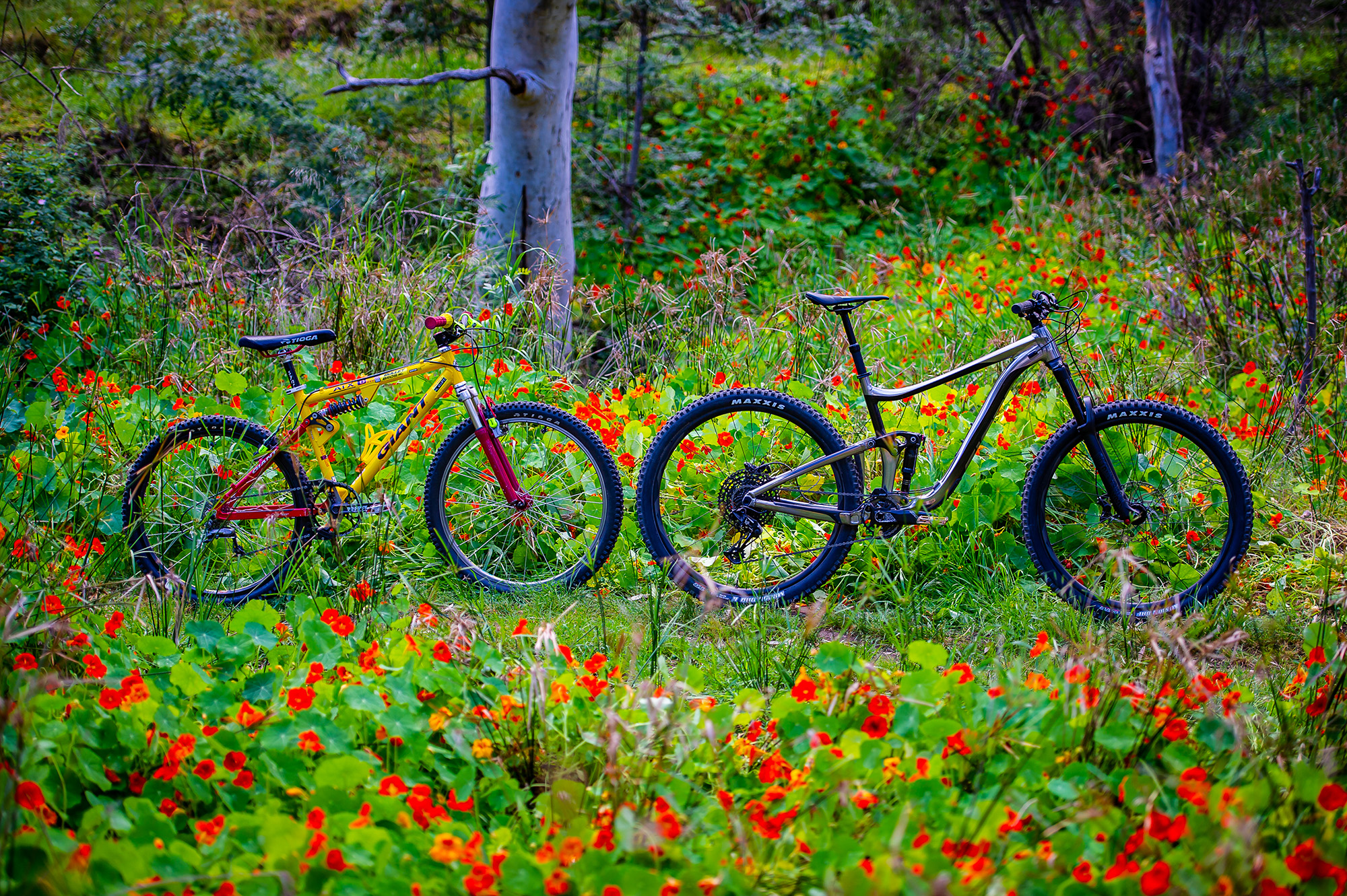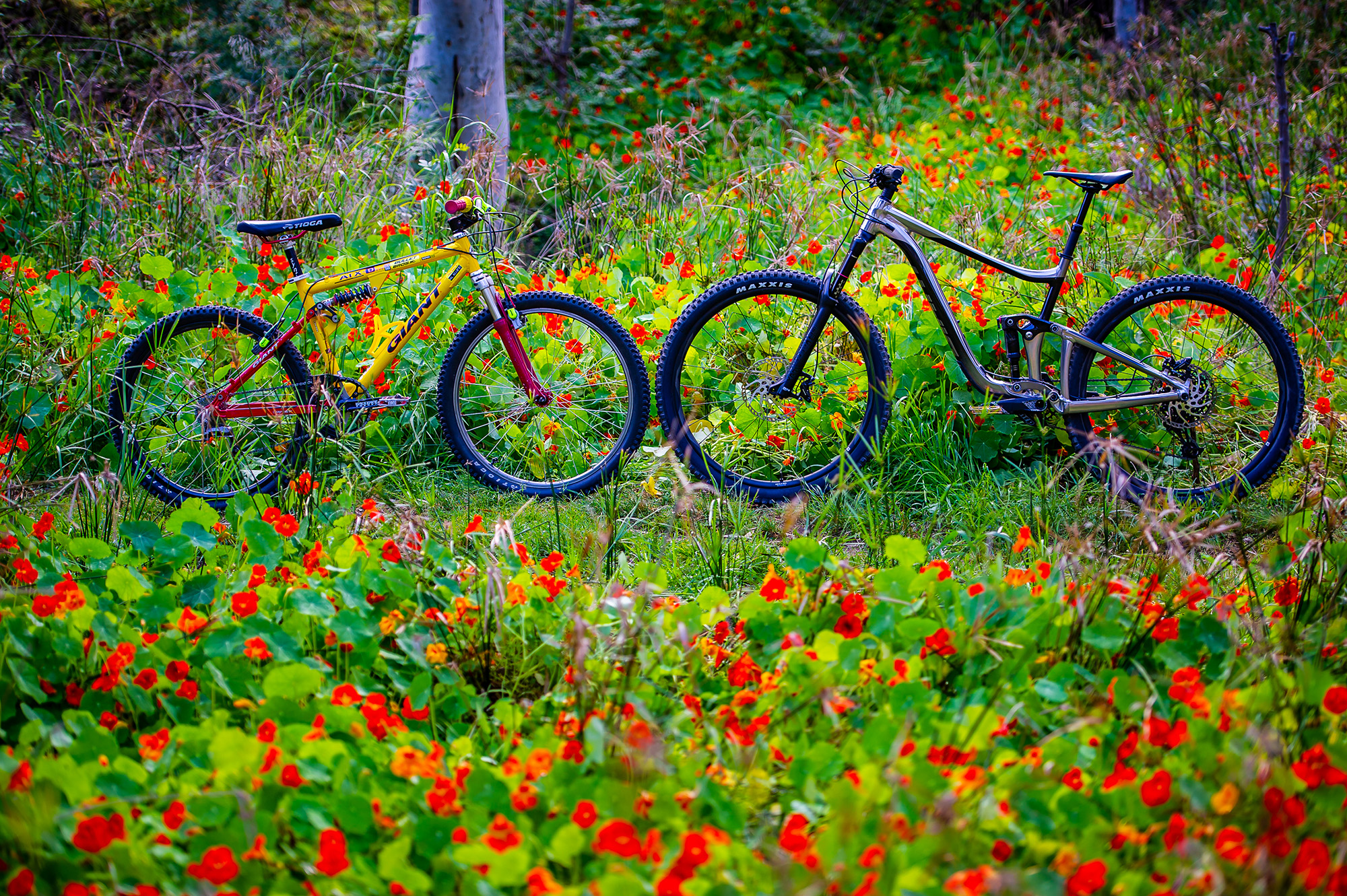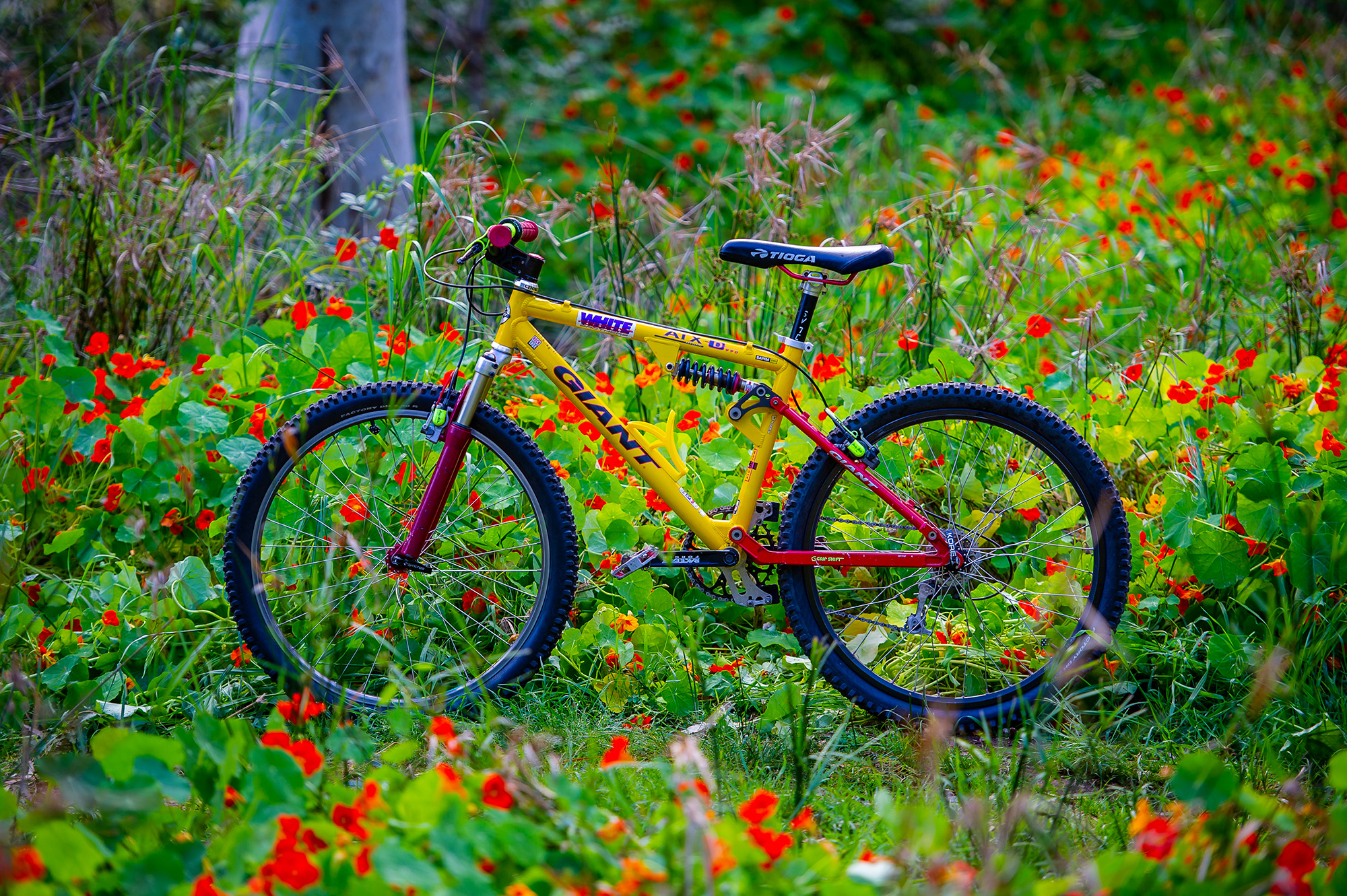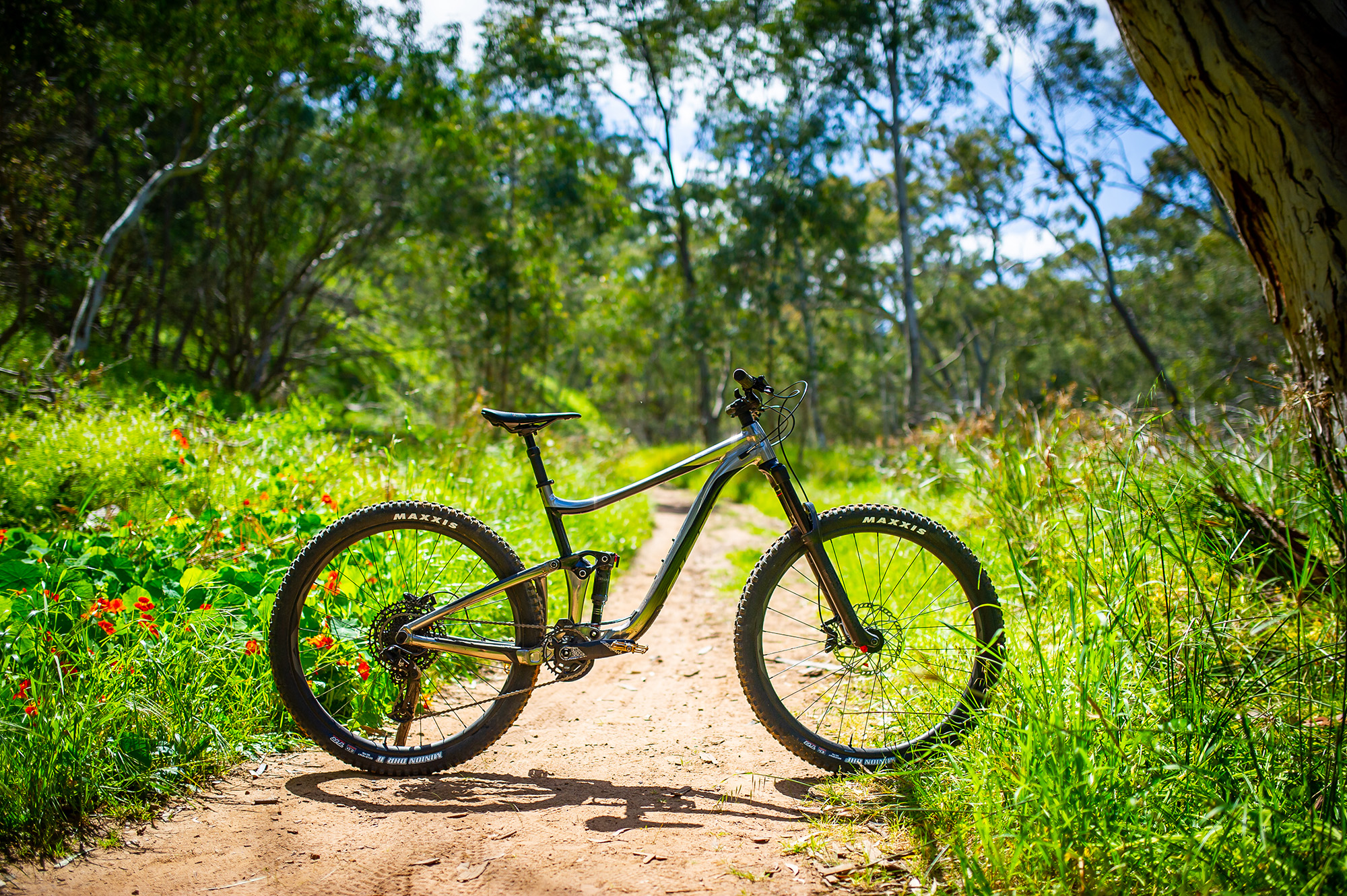23 years of Giant’s precious metals
Back in 1996, at the height of MTB’s golden era, the most badass rider on the planet was American multi-World Champ, John Tomac. His weapon of choice at the time was, of course, the iconic yellow Giant ATX 990 decked out with only the very best componentry of the day. His bike was genuinely made of ‘unobtanium’ as it was impossible to even think about being able to buy the same parts. Back then ultra-high-performance bikes were nowhere near as attainable as bikes today.
Most of the bikes being raced at World Cups were prototypes and if they ever did hit production numbers were often limited to just a handful. With that being the case, it was extremely rare to see these bikes in the flesh, instead, they were often just a thing of dreams that we’d all drool over in magazines.
Words // Darren Mallard Photos // Kane Naaraat
The ’90s were an extremely exciting time in our sport as mountain bike designs and component technology was rapidly and radically evolving. What was ‘cool and cutting edge’ one day was often gone the next, replaced with concepts that pushed the envelope of design even further. Without a doubt, it was a time of trial and error for bike manufactures who were chasing racing success and ultimately market share. Designs that failed died and the ideas that worked survived. And so as the years went on bike designs evolved to become less outrageous as certain designs became proven, more reliable and ultimately more refined.
Giant has always been at the forefront of mountain bike R&D. The ATX 990 that JT used to race went on to become one of the most influential mountain bikes of all time. If you did a DNA ancestry chart of the recently released Reign29 you’d find the ATX’s DNA running through its tubes. Sure, the wheel size and amount of travel (amongst many other things) might have grown over the years but one thing that these two bikes showcase, albeit 23 years in age apart, is that Giant still produce some of the absolute finest alloy bikes on the planet.
Before we set out on our review of the new Reign29 we first wanted to take a walk down memory to see just how far bike design and component technology has transformed since the original ‘golden era’. Get ready for a solid dose of nostalgia from yesteryear as well as a detailed look at one of the most impressive long travel-trail bikes on the market today.
 Head to Head
Head to Head
| 2020 Giant Reign 29 | 1996 Giant ATX 990 | |
| Seat Tube Length (mm) | 431 | 430 |
| Seat Tube Angle | 76.8° | 74 |
| Top Tube Length (mm) | 573 | 535 |
| Head Tube Length (mm) | 100 | 110 |
| Head Tube Angle | 65.0 | 69 |
| Wheelbase (mm) | 1188 | 1050 |
| Chain Stay Length (mm) | 439 | 439 |
| Bottom Bracket Drop (mm) | 30 | 0 |
| Reach (mm) | 428 | 380 |
| Stand Over Height (mm) | 754 | 735 |
| Stem Length (mm) | 40 | 70 |
| Crank Length (mm) | 165 | 170 |
| Wheel Size | 29” | 26” |
| Price at Time | $3999 (as tested) | $2275 (stock spec) |
| Price of a Big Mac at time | $6.45 | $1.97 |
 The 1996 Giant A.T.X. 990
The 1996 Giant A.T.X. 990
When we first came up with the concept for this article I knew there was one person who was guaranteed to have a period-correct A.T.X. and that was, of course, Krishan Spranz of Eighty-one Spices. He has an epic collection of ‘vintage’ bikes and he was more than happy to let us get our grubby little hands on this immaculate and stunning 1996 Giant ATX 990 D. This was ‘the dream bike’ for anyone who grew up in the era as it was the first dual suspension bike to be aimed at D.H. for the mass market.
On the first release of this bike, the TIG-welded alloy frame was adorned with a mid-level mix of Shimano LX drive train, Mavic 220 rims, Judy XC forks, and a RockShox Coupe Deluxe rear shock. This was a reasonably good build for the time but, I was lucky enough to jump on a bike built to replicate John Tomac’s race bike from the day. The forks have been upgraded to the Judy DH with a massive 80mm of travel. The 80mm of travel was initially controlled by elastomer (a spongy plastic), the spring rate would change with the temperature (stiffer in the cold, softer in heat), we were lucky enough to have a speed spring upgrade that still worked remarkably well and had a good range of preload adjust. Unfortunately, the rebound circuit was broken and reacquainted us with what top out actually is. The Ultimate Coupe Deluxe came in coil and had preload adjust. Talk about set and forget!
The Grip Shifter was now operating an XTR rear mech to shift through the 8 speed 10-28 rear cassette. On the front the 3 speed Deore crank was replaced with a very sought after Race Face Forged crank specced with a 46T front ring. This combo leads to a fantastic amount of speed downhill and a whole lot more walking uphill. The grip shift, while stiff, was terrific and never miss-shifted while changing body position.
“After 25 years of sitting redundant, the derailleur behaved flawlessly and never missed a beat. I still don’t know how all this fitted on a 590mm bar and riders yet found room to hold on.”
It isn’t until you get to the rims and brakes that you are genuinely blown away with the crazy ideas of the time. Originally the bike was sold with standard v brakes. These were about as effective as jamming ice blocks against the rim when it came to stopping. What was the solution? Well, discs hadn’t been invented yet so, the next best thing, Magura HS-22 hydraulic rim brakes A.K.A. “Rim Crushers”. A system that placed two hydraulically activated pistons on each side of the rim that would clamp the rim using pads. Aptly named because as the brakes would inevitably wear through your rims and under immense pressure crush your rim. Everyone saw this flaw; however, the power was needed to retain some form of safety. Ceramic coated rims were the only way forward when it came to sidewall integrity and braking grip. The exterior coating allowed a different braking texture, better heat management, and extra strength to prevent the rim crushing as much as possible. I was stoked to have them on this bike because I would hate to know how bad the brakes would be without any help.
To be completely honest (and perhaps a tad snobbish) I have had the opportunity to ride some real superbikes in my time, and while I was excited to ride this bike, I couldn’t shake the feeling I would be underwhelmed. To my complete surprise, I was absolutely blown away with how this bike performed. Of course, it wasn’t as advanced as a new enduro bike but, it wanted to be. As I looked down at that tiny little 26-inch wheel, I knew I was going to be in for a wild ride. The first corner reminded me not only how agile these wheels were, but, how easy it was to turn way too hard on them. After nearly washing out on the first corner, I quickly got back to refining my inputs. Because this bike is a treasure to the owner, I didn’t get it too air-born however I believe it would pop up nicely and be a pleasure to do a 90’s inspired bar tweak on. The suspension mixed with an oddly stable geometry meant this bike loved to track the ground and provided a feeling of confidence once getting to speed on a straight. In the tyres were these weird things called “tubes”, I don’t know what they did to help performance, I guess they did something back in the day. With a 46 tooth ring up front and a 28 outback climbing wasn’t the best on this bike but, it was a bunch of fun on the way down.
“What truly inspired me to write about this bike was the amount of innovation at this period of M.T.B. history.”
This bike was a good bike when it came to the market but, as we always do, mountain bikers wanted to charge harder, go faster, and try to crash as little as possible. I mean, would you look at the snowflake lacing on the rear wheel? This wasn’t just to attract attention on the trails, this was an attempt at making the wheels stiffer with stock parts. Not running ‘cantis? Swap the fork crown for an HS-22 crown. Want more rear travel? Hit up an Adelaide local and get some modified links, or even make your own. If something didn’t work how you wanted the only way to change it was by making it yourself. Experimentation was the theme of the era, and without it, we wouldn’t be on the bikes we are now.
 2020 Reign29 ‘2’
2020 Reign29 ‘2’
What has all this innovation led to? Well if we were to look at the industry today, it’s hard to argue that “Enduro” or long-travel trail bikes aren’t the most significant section of the market at the moment. All of the innovation on bikes from the past has given us bikes that now ride uphill like an old xc bike and bomb down like a top-level D.H. bike from the same era. Big companies like Giant have looked at what riders were doing to the bikes they bought and re-designed their bikes to accommodate the market. Better suspension can now be tuned for each rider, the geometry has been optimized to do everything, and suspension kinematics have been fine-tuned to suit the riding.
While the Giant Reign has been a staple bike in the enduro market for a long time, the release of the new 29’er version this year sets the bike as the pinnacle of Giant’s engineering endeavours. If we were to compare it to the A.T.X., which is 25 years plus older, there aren’t too many similarities. Gone are the ceramic rims, the hydraulic callipers are now clamping discs, and you can now adjust almost every aspect of the rear shock. While the Reign 2 is not the top of the line model in today’s standards, it’s performance sure as hell would have been back in 1996.
Weight-wise this bike tips the scales at around the 14.5 kg mark, which isn’t the lightest bike on the market the Maestro suspension makes this bike pedal like a dream. While the geometry would lead you to think this bike is only built to descend, it indeed leads me that way, the Reign’s hidden talent is in its surefooted climbing ability. The steep 76.5 seat angle and 493mm reach (Size L) provide a balanced position that never had me thinking about body position while climbing. Even in steep slow tech riding I never really found myself shifting position on the saddle or fighting the front wheel to stop it flopping about. The Maestro suspension restricted pedal bob to the perfect amount of traction vs efficiency. A centralized body position also leads to a more significant reaction from the bike when you did lean back or get out the saddle to power through a section.
After enjoying the climb up and turning the bike to chargeback down the hill, I found myself surprised that it ate up everything thrown at it. There are not many bikes that are truly “do it all” bikes; however, the Reign comes bloody close. Again, thanks to the very central feeling on the bike, as long as you are in an aggressive position, it will react how you want it. When you tell this bike to do something, it just does it. Now, as I mentioned, it came close to doing everything well. As a rider that loves to nail a corner as hard as I can, 29ers have always loved to have a wider arc to maintain speed. The Reign, on the other hand, loved to blast a berm and square it off.
“It blew me away every time I would tip it in, hear the tyre scream for traction (mercy), and then the classic pedal wheelie out. It is the best and most consistent cornering bike I have ridden in a very long time.”
As mentioned, this bike is the entry-level bike in the range, and at a smidge under $4,000 I was a bit dubious about the level of spec. Sure, the NX level SRAM drivetrain is a little on the heavy side and it lacks a bit of ergonomic adjustment but, never skipped a beat. The deluxe shock was great until it would heat up and became a bit under dampened. A simple fix was to run the rebound a bit slower when you were charging hard. The Yari fork runs the same chassis and air spring as its big brother Lyrik however, it runs the older Motion Control Damper. Like the rear shock, it suffered when the going got rough. The thing is, these parts performed faultlessly 90% of the time. If you want to upgrade the fork, spend $200 on charger 2.1 damper, and you have a Lyrik. An extra $650 ish will get you a super deluxe rear shock, and you will have a truly elite level rig. Why wouldn’t you buy the next model? I hear you ask, but, as a budget bike, this will allow you to ride NOW and ride better later. The perfect entry-level balance.
In my mind, the two real ‘stand out’ components on this particular bike are its wheels and brakes. As anyone reading this that knows me knows (and the mag’s editor can definitely be counted on that list), I have a tendency to break shit. Especially bicycles! At one point during the test, I hit a berm with a bit too much gusto and not enough air pressure (maybe that’s what tubes were for), inevitably I burped more air and proceeded to blow through a rock garden. This usually results in me looking for a new rim, again. Thankfully this time the Giant wheel held up amazingly with only the tiniest of dents. A set of multi grips and a metal tyre lever fixed the problem, and it was beautiful. The brakes on this bike are truly the unsung hero of the entire Shimano range. The no-name M520 lever paired up with a 4 piston (X.T. 4 pot) calliper performed as well at the $700 elite level brakes on my own bike. While it did have me crying into my wallet, they had me smiling on the trail. They were never overwhelmed, remained consistently powerful, and could do the biggest of skids. The classic on/off feel of Shimano brakes did remain however I got reacquainted fast and fell in love.
“When I wrap up a bike test the one thing I like to ask myself is if I would go ahead and spend my hard earned money to buy one for myself?”
And I can tell you, this Reign29 is definite yes to that question. Over the years, I have always managed to get reasonable prices on higher level bikes, so my understanding of actual retail has been skewed. Sure, the latest top of the line carbon fibre ‘XYZ’ brand bike is probably going to ride amazing, for probably well over $10,000 you would hope so too. But the fantastic thing about the Reign29 ‘2’ is that an entry-level rider or everyday punter can walk into a shop, probably even negotiate a free set of pedals and bottle cage and go and race competitively that day for $3,999. To me, this is where the innovation has truly led, to bikes people can get for a great price and ride hard from the get-go. This is how bikes like the A.T.X. have grown our sport to the brilliant level that we all now get to enjoy (and probably take for granted!). [R]























